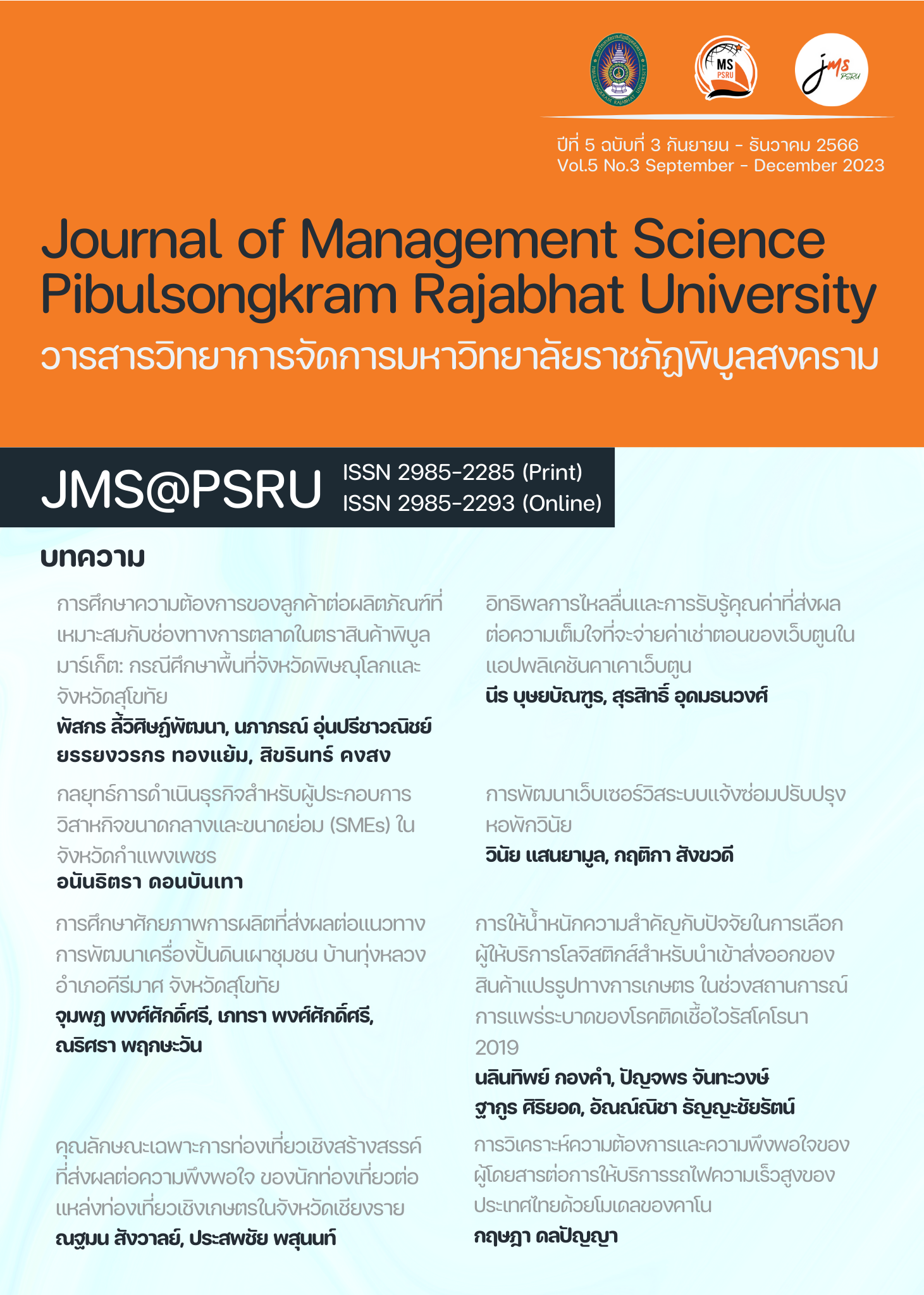The Affecting Creative Tourism Characteristics on Satisfaction of Tourists towards Agri-tourism Attractions in Chiang Rai Province
Keywords:
Creative Tourism Characteristics, Satisfaction, Agri-Tourism AttractionsAbstract
The objectives of this research were to study six specific characteristics of creative tourism and investigate the effects of characteristics of creative tourism on the satisfaction of tourists towards agri-tourism attractions in Chiang Rai Province. The participants were 227 tourists who had experience traveling in agri-tourism attractions in Chiang Rai Province. The data were collected by using a questionnaire. By G*Power 3.1 program, the data were analyzed by percentage, mean, and standard deviation, Pearson's Correlation Coefficient and multiple regression analysis. The results showed that the opinion of agricultural tourism sites emphasizing local identity was at a high level (=4.40, S.D.=0.549), and tourists participating in tourism activities was also high (
=4.38, S.D.=0.550). The mean of opinion of the main products of agricultural tourist attractions was (
=4.38, S.D.=0.550), and agricultural tourist attractions focus on daily culture was (
=4.29, S.D.=0.641). In terms of agri-tourism attraction, the emphasis was placed on intangible tourism resources at a high level (
=4.21, S.D.=0.701). However, in terms of tourism activities within agricultural tourist attractions, the mean was a moderate level (
=3.47, S.D.=0.825) In addition, the independent variables affecting satisfaction in 4 aspects were at a high level (
=4.27, S.D.=0.589), namely, attraction products, intangible tourism resources, daily culture, and unique local area at statistically significant level 0.05. Therefore, agri-tourism attractions in Chiang Rai can be developed to meet tourists’ needs.
References
กระทรวงการท่องเที่ยวและกีฬา. (2564). สถิติด้านการท่องเที่ยวปี2564. สืบค้น 29 มีนาคม 2566, จาก https://www.mots.go.th/news/category/628
ขวัญลดา ธีร์ธนังกูร คะนึงรัตน์ คำมณี จิรัฐินาฏ ถังเงิน และพันธ์จิตต์ สีเหนี่ยง. (2564). ความพึงพอใจของนักท่องเที่ยวต่อการจัดการท่องเที่ยวเชิงเกษตรไผ่ขตองตำบลหนองงูเหลือม อำเภอเมือง จังหวัดนครปฐม.วารสารวิทยาศาตร์เกษตรและการจัดการ, 3(3), 38-45
เพียงใจ คงพันธ์ และภัทราวรรณ วังบุญคง. (2564). ความพึงพอใจของนักท่องเที่ยวชาวไทยที่มีต่อการท่องเที่ยวเขาศูนย์จังหวัดนครศรีธรรมราช. วารสารมนุษยศาสตร์และสังคมศาสตร์ มหาวิทยาลัยราชภัฏอุบลราชธานี, 12(1), 15-29.
วันวิสาข์ พลอย อินสว่าง ดุสิตพร ฮกทา และอัญชิษฐา กิ้มภู่. (2564). การพัฒนาศักยภาพการท่องเที่ยวเชิงสร้างสรรค์เพื่อการเรียนรู้ ในแหล่งท่องเที่ยวจังหวัดตรังอย่างมีส่วนร่วม. ใน การประชุมวิชาการระดับชาติ ครั้งที่13 (น.2394). นครปฐม: มหาวิทยาลัยราชภัฏนครปฐม.
วุฒิชัย อารักษ์โพชฌงค์ และประสพชัย พสุนนท์. (2556). การรับรู้การสนับสนุนจากองค์การและความสุขในการทำงานที่มีต่อการดำเนินงานด้านนวัตกรรมของบุคลากร คณะสังคมศาสตร์และมนุษยศาสตร์ มหาวิทยาลัยมหิดล. วารสารคุณภาพชีวิตกับกฎหมาย, 10(1), 90-105.
สุจิตรา หนูมี (2562). พฤติกรรมนักท่องเที่ยวชาวต่างชาติต่อการท่องเที่ยวเชิงสร้างสรรค์ กรณีศึกษาอำเภอ เกาะสมุย จังหวัดสุราษฎร์ธานี. (วิทยานิพนธ์ปริญญามหาบัณฑิต). กรุงเทพฯ: สถาบันบัณฑิตพัฒนบริหารศาสตร์.
องค์การบริหารการพัฒนาพื้นที่พิเศษเพื่อการท่องเที่ยวอย่างยั่งยืน. (2561). การท่องเที่ยวเชิงสร้างสรรค์. สืบค้น 6 พฤศจิกายน 2565, จากhttps://www.dasta.or.th/uploads/article/202107/ 1626097803_fa2ff35eb41a4fcc3ac2.pdf
Binkhorst, E. (2006). The co-creation tourism experience. In XV International Tourism & Leisure Symposium 2006. Barcelona: Persona Ciencia Empresa Universitat Ramon Llull.
Buhalis, D. (2000). Marketing the competitive destination of the future. Tourism management, 21, 97-116.
Faul, F., Erdfelder, E., Buchner, A., & Lang, A. G. (2009). Statistical power analyses using G* Power 3.1: Tests for correlation and regression analyses. Behavior research methods, 41(4), 1149-1160.
Hair, J. F., Ortinau, D. J., & Harrison, D. E. (2010). Essentials of marketing research (Vol. 2). New York: McGraw-Hill
Hung-Che Wu, Chi-Han Ai, & Ya-Yuan Chang. (2021). RETRACTED ARTICLE: What drives experiential persistence intentions: The case of gay tourism. Journal of China Tourism Research, 18(4), DOI: 10.1080/19388160.2021.1904078
Richards, G. (2010). Creative Tourism and Local Development. In Creative tourism: A global conversation. United States: Sunstone Press.
Richards, M. D., Fetter, R. B., Flippo, E. B., Roman, C., & Stockton, R. S. (1961). Report of Membership Committee. Academy of Management Proceedings, 1961(1), https://doi.org/10.5465/ambpp.1961.27709474
Downloads
Published
How to Cite
Issue
Section
License
Copyright (c) 2023 Pibulsongkram Rajabhat University

This work is licensed under a Creative Commons Attribution-NonCommercial-NoDerivatives 4.0 International License.
บทความที่ได้รับการตีพิมพ์ในวารสารวิทยาการจัดการมหาวิทยาลัยราชภัฏพิบูลสงคราม เป็นลิขสิทธิ์ของมหาวิทยาลัยราชภัฎพิบูลสงคราม
บทความที่ลงพิมพ์ใน วารสารวิทยาการจัดการมหาวิทยาลัยราชภัฎพิบูลสงคราม ถือว่าเป็นความเห็นส่วนตัวของผู้เขียนคณะบรรณาธิการไม่จำเป็นต้องเห็นด้วย ผู้เขียนต้องรับผิดชอบต่อบทความของตนเอง


